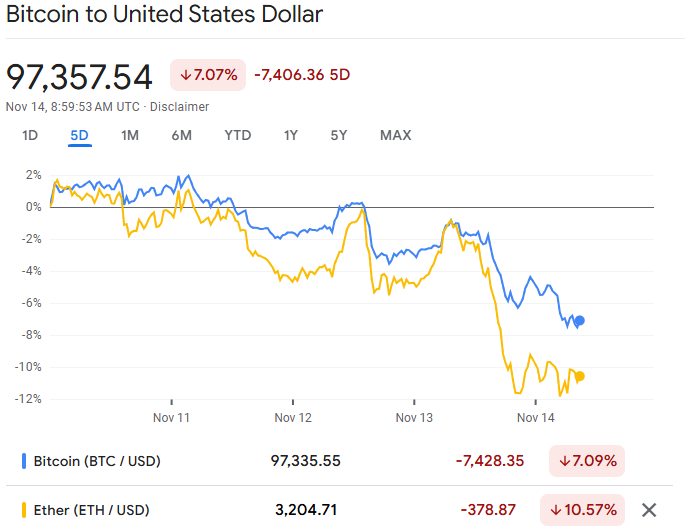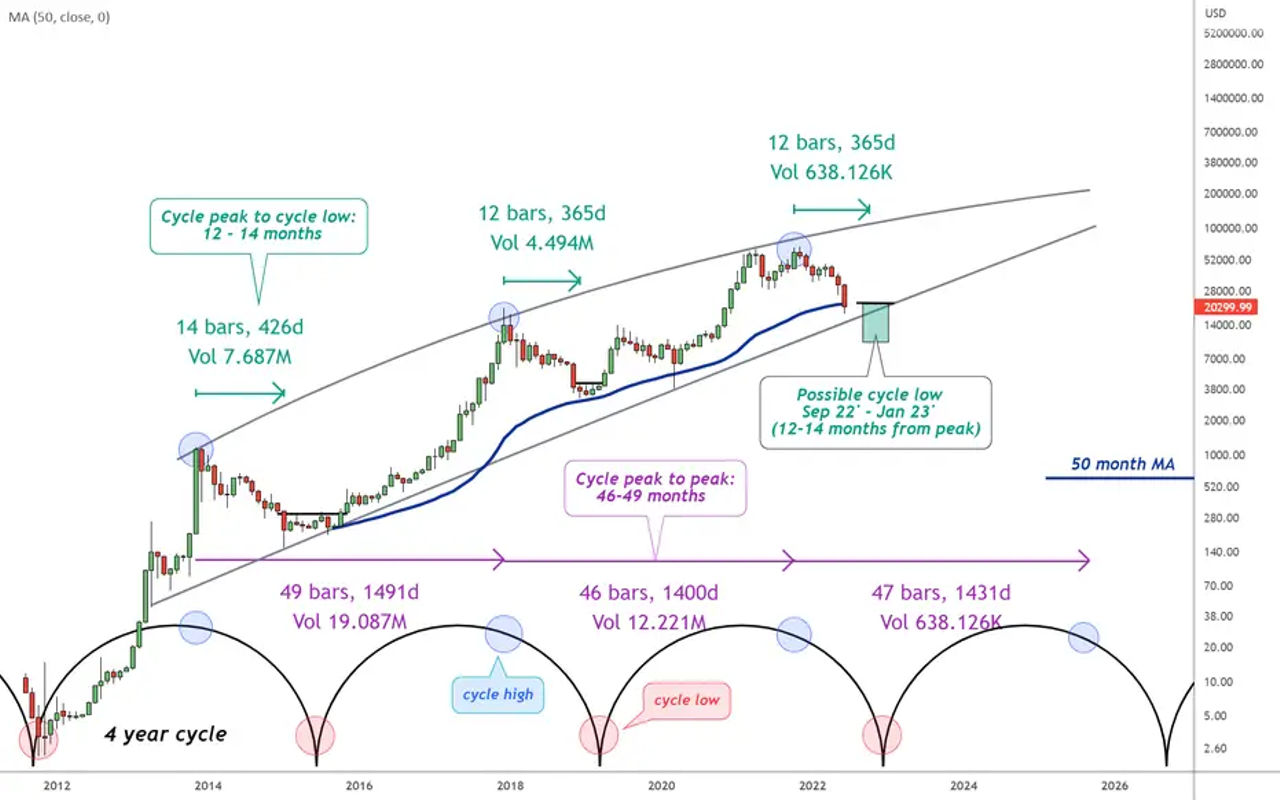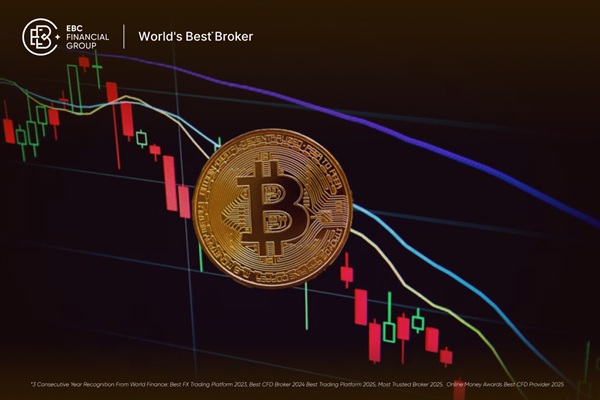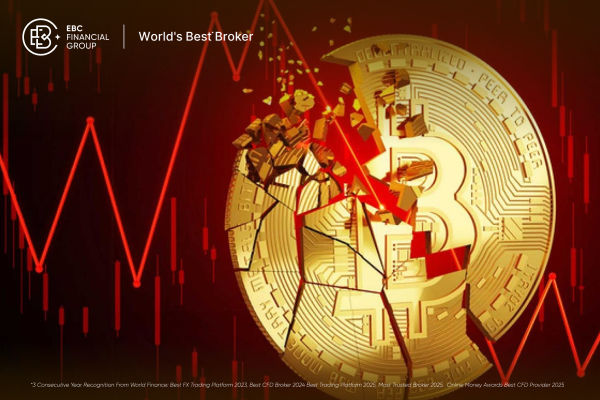The crypto market has taken another sharp downturn, with Bitcoin slipping roughly 14.2% and Ethereum falling about 24% since mid-October. This latest pullback has rattled investors, especially after its strong year marked by institutional adoption, ecosystem growth, and rising long-term conviction.
But today, the question dominating search trends, trading desks, and social media feeds is far straightforward and far more urgent: Will crypto recover from its latest dip?
To answer this, we need to look beyond the headlines and examine the market's structural backdrop, sentiment dynamics, technical signals, and the broader macro environment that's shaping every risk asset in November 2025.
Where Crypto Stands Now: November 2025 Market Snapshot

This downturn did not emerge in isolation. It follows a turbulent October, which marked the first negative month for the crypto market since 2018, with total market capitalisation contracting by around 6.1%.
As of November 14, major cryptocurrencies recorded fresh losses of 2–7%, reinforcing concerns that the pullback may not be over.
Beneath the market volatility, institutional investors are steadily repositioning. Recently, one firm acquired over 4,000 BTC, valued at nearly $400 million, highlighting how long-term buyers tend to accumulate during periods of fear rather than optimism.
Price Movements at a Glance
Bitcoin: Fell from near $105,000 to briefly below $98,000, reversing part of its multi-month rally that peaked in October.
Ethereum: Lost another ~3%, trading under $3,500, showing clear short-term weakness.
Altcoins: Broad declines of 10–15%, reflecting elevated risk aversion and thinning liquidity.
Market Structure & Institutional Positioning
The structural picture is complex. On one hand, Bitcoin dominance climbed to 59.4%, underscoring consolidation around the strongest asset. On the other hand, institutional behaviours show caution rather than conviction:
Options activity is skewing toward hedging, not directional longs.
ETF and fund flows have registered recent outflows, though selective OTC accumulation continues.
The Crypto Fear & Greed Index has collapsed to ~15, deep in "extreme fear", a zone historically associated with early-stage recovery setups.
Meanwhile, according to Binance Research (October 2025):
DeFi TVL dipped ~4.85% MoM.
NFT volumes rose ~11.5%, helped by surges on the Bitcoin and Base chains (+28.7% and +71.6%, respectively).
Between structural weakness, scattered strength, and intense pessimism, the market resembles a transitional phase, one where conditions are fragile but not devoid of opportunity.
The Four Major Signals That Will Determine Whether Crypto Recovers

Crypto rarely recovers on "hope" alone. Sustainable rebounds typically require alignment across four pillars: technical strength, sentiment turnarounds, macro support, and fundamental catalysts.
Today, each of these pillars is sending mixed but revealing signals.
1. Technical & Trend Indicators: Are Markets Near a Bottom?
Technical structure often leads sentiment in crypto cycles. When fear is at its peak, trends would show early signs of reversal before narratives catch up.
Key Levels and Indicators to Watch
Bitcoin support at $100,000 and more critically $98,000
Ethereum needs to reclaim the $3,500 zone
Indicators such as RSI, MACD, and moving averages
On-chain dynamics like whale accumulation, exchange outflows, and supply tightening
Current Market Readings
Ethereum's violation of its $3,500 pivot confirms short-term bearish pressure. Bitcoin's defence of the $98,000 area remains crucial; a firm break below could open the door to deeper correction levels.
Crypto's relationship with risk assets remains close. Weakness in tech equities, bonds stabilising at higher yields, or a stronger U.S. dollar typically translates into pressure on digital assets.
For now, the charts are signalling caution, not collapse.
2. Market Sentiment & Institutional Flows: Extreme Fear Meets Selective Accumulation
Sentiment remains deeply negative. But in crypto, extreme pessimism often precedes turning points.
What the Market Is Feeling Now
The Fear & Greed Index at ~15 indicates widespread capitulation.
Retail traders appear exhausted, with growing evidence of forced selling.
Institutional flows are mixed with short-term outflows alongside long-term accumulation.
Critical Events Driving Near-Term Volatility
Nearly $5 billion in Bitcoin and Ethereum options are set to expire on November 14, 2025, potentially triggering substantial market shifts as traders rebalance hedges and adjust directional positions.
Even as overall sentiment remains grim, the significant accumulation of 4,094 BTC (~$405 million) by a single investment firm reinforces that selective conviction is alive beneath the surface.
3. Macroeconomic Backdrop: A Critical Variable in Crypto's Fate
The path of crypto is intertwined with the broader economic landscape. Rising yields, shifting rate expectations, and geopolitical uncertainty can override even strong industry-specific developments.
What's Driving Macro Volatility Now
The end of the U.S. government shutdown triggered a mixed reaction:
Bitcoin slipped 1.8%, stabilising near $103,000.
Ethereum fell 0.7%, hovering near $3,500.
When macro headwinds collide with fragile crypto sentiment, recoveries tend to be slower and more segmented.
4. Fundamental Catalysts: Where Real Momentum Could Come From
Fundamentals matter more in 2025 than in any previous cycle.
What's happening beneath the surface
NFT activity continues expanding despite market weakness.
However, market oversaturation, with more than 37 million unique tokens, raises concerns about long-term fragmentation. [2]
Meaningful recovery may depend on:
Network upgrades
Institutional integrations
Regulatory clarity
DeFi revitalisation
Crucially, the industry seems positioned for a stronger 2026, but many foundational pieces must be reassembled first.
What Past Crypto Cycles Reveal About Recovery Timing

History doesn't repeat exactly, but it does rhyme. Typically:
Major bottoms occur after leverage is flushed out.
A multi-month accumulation phase usually follows.
Breakouts arrive last, once conviction rebuilds.
The October decline (~6.1%) is notable but not catastrophic; it suggests early-phase consolidation rather than a full bear-market collapse. That means the current cycle may be entering its base-building stage, where volatility remains elevated but downside slows.
What Could Delay or Derail a Recovery?
A realistic assessment requires acknowledging genuine risks:
Losing key support levels, especially Bitcoin's $98,000 zone
Macro shocks: surprise Fed tightening, dollar surges, or geopolitical escalations
Failed catalysts: upgrades or adoption waves falling flat
Structural oversupply: too many tokens chasing too little capital
Sentiment traps, where a short-lived bounce evaporates quickly
The market is fragile and recovery is possible, but not guaranteed.
How Investors Should Position Themselves Now

Short-Term Traders
Watch for breakouts at critical levels.
Manage risk aggressively.
Use volatility to your advantage, but stay disciplined.
Medium & Long-Term Investors
Dips can be opportunities, but only for assets with strong fundamentals.
Consider staged accumulation rather than lump-sum entries.
Look for alignment across the four key recovery points.
Cautious or Beginner Investors
Conclusion
In conlusion, crypto can recover, but recovery will require confirmation, not blind optimism. The market is not collapsing, but neither is it poised for an immediate new bull run.
Instead, we are likely entering a selective and gradual recovery phase, one that favours fundamentally strong assets such as Bitcoin and Ethereum over smaller speculative plays.
The path forward hinges on a delicate balance of macroeconomic trends, shifts in market sentiment, catalytic structural developments, and sustained price stability. Until these align, investors should focus on discipline, diversification, and patience rather than assumptions of an automatic rebound.
Frequently Asked Questions
1. What Key Levels Must Bitcoin and Ethereum Surpass for a Meaningful Recovery?
Bitcoin needs to hold above roughly $107,000 and Ethereum above $3,300 to signal renewed strength.
2. Is Institutional Money Returning to Crypto?
Yes. For example, U.S.-listed Bitcoin ETFs recently saw inflows of $523.98 million, indicating renewed interest. [3]
3. Is the Crypto Market Risky Right Now?
Absolutely. Volatility remains high amid macro uncertainties and regulatory shifts.
4. What Macro Events Matter Most?
Fed policy, geopolitical tension, government shutdown effects, and global risk appetite continue to shape crypto movements.
Disclaimer: This material is for general information purposes only and is not intended as (and should not be considered to be) financial, investment or other advice on which reliance should be placed. No opinion given in the material constitutes a recommendation by EBC or the author that any particular investment, security, transaction or investment strategy is suitable for any specific person.
Sources
[1] https://www.barrons.com/articles/bitcoin-crypto-xrp-price-selloff-83966c8b
[2] https://tangem.com/en/blog/post/how-many-cryptocurrencies-exist/
[3] https://economictimes.indiatimes.com/news/international/us/bitcoin-price-is-recovering-fast-at-104873-50-up-1-73-why-is-btc-surging-today-can-btc-sustain-momentum-as-etf-inflows-return-bitcoin-hits-recovery-barrier-as-volatility-rises/articleshow/125275571.cms
























